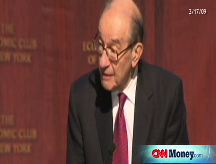Bond prices dip
U.S. Treasurys edge lower as investors weigh Obama's foreclosure prevention plan and the debt associated with the stimulus regime.
NEW YORK (CNNMoney.com) -- Treasury prices dipped Wednesday as the government unveiled a $75 billion housing stimulus program.
President Obama formally announced the plan to help up to 9 million home owners struggling to pay their mortgages payments in a speech in Mesa, Arizona Wednesday.
To fund the government's massive stimulus repertoire, the U.S. will issue more debt, pushing Treasury prices lower. Still, some investors were skeptical whether the economy would respond to the spending jolt.
Treasurys are "a little bit trapped," said Chris Currer, director of fixed income trading at BMO Capital Markets, trying to determine when the bulk of debt supply would hit the market.
"There is a lot of consensus that this stimulus spending is not all front end loaded," said Currer. "On the other hand, it is irrefutable that there is a tidal wave of government supply coming to this market in the medium-term."
Wednesday, the government sold $36 billion worth of 28-day bills. The Treasury was set to auction 2-year notes, 5-year notes and 7-year notes next week, among other shorter maturity notes. Last week, the government completed a $67 billion refunding.
Stimulus, stimulus, stimulus: President Barack Obama unveiled a new housing rescue plan Wednesday. The plan would run $75 billion and is intended to reach 9 million homeowners with restructured, refinanced loans.
Tuesday, the President signed into law the $787 billion American Recovery and Reinvestment Act, but it didn't relieve the stock market. Wall Street fell hard Tuesday, with the Dow sinking almost 300 points, and bond prices surging.
Meanwhile, the auto industry pleaded its case for more cash from Uncle Sam. General Motors (GM, Fortune 500) and Chrysler LLC said Tuesday that they could need an additional $21.6 billion in government loans.
To pay for stimulus programs, the government has been selling record amounts of debt. Investors have worried about foreign demand. But, a report released Tuesday from the Treasury International Capital (TIC) said net foreign purchases of long-term Treasurys were $15 billion in December, a relief after November, when foreign investors sold a net $25.8 billion.
Bond prices: On Wednesday, the price of the 10-year note ticked down 27/32 to 100-2/32 and its yield rose to 2.7%. Bond prices and yields move in opposite directions.
The 30-year bond dipped 1 7/32 to 99-7/32, and yielded 3.54%. The 2-year note edged down 6/32 to 99-27/32 and its yield rose to 0.96%.
The yield on the 3-month note was at 0.31%. Demand for the shorter-term note is seen as a gauge of investor confidence.
Lending rates: Federal Reserve ChairmanBen Bernanke delivered a speech Wednesday detailing the central bank's commitment to restoring credit markets to health.
"In the United States, the Federal Reserve has done, and will continue to do, everything possible within the limits of its authority to assist in restoring our nation to financial stability and economic prosperity as quickly as possible," Bernanke said.
Libor rates have fallen since the height of the credit crisis, but credit markets are still flagging.
The 3-month Libor rate remained unchanged from Tuesday's 1.25%, according to data on Bloomberg.com. The overnight Libor rate, meanwhile, dipped to 0.30% from 0.31%.
Libor, the London Interbank Offered Rate, is a daily average of rates that 16 different banks charge each other to lend money in London.
Two credit market gauges were mixed. The "TED" spread held steady at 0.95 percentage points. The bigger the TED spread, the less willing investors are to take risks.
Another market indicator, the Libor-OIS spread, widened to 0.99 percentage point from 0.98 percentage point the previous day. The wider the spread, the less cash is available for lending. ![]()




